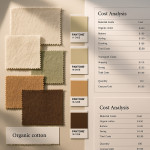On-demand weaving services: directory filters recruiters use to spot a couturier
Recruiters type a few keywords, tick some boxes and—boom—only a handful of couturiers remain visible in their directory search. This article unpacks every filter that matters in on-demand weaving services and shows you how to turn them into magnets for high-value commissions.
Why on-demand weaving directories dominate couture recruiting

Fashion buyers, film costume departments and luxury interior brands follow a brutal schedule. They open a directory, apply filters for style, capacity and location, and shortlist the top three profiles that match their brief. The process is faster than email outreach and avoids agency mark-ups. If your profile is incomplete or mis-tagged, you simply vanish from consideration.
Filters recruiters rely on—and how to ace each one
1. Style tags & sub-style accuracy
Filters such as “Jacquard evening wear” or “Minimalist linen” are now standard. Avoid broad labels like “contemporary”. Instead, break down your expertise into micro-styles: “Hand-loomed Ikat for bridal capes” or “Zero-waste drape panels”. Rich taxonomy makes you discoverable and aligns with advice in building a narrative-driven couturier profile.
2. Fabric expertise & sustainability badges
Green claims are no longer optional. Directories let recruiters filter for GOTS, OEKO-TEX Standard 100, or recycled-fiber credentials. Upload certificate PDFs and add verifiable serial numbers. For deeper guidance, check the eco-textile sourcing guide.
3. Geo-targeting & production lead time
“Within 200 km” and “Ships in under 10 days” are common sliders. Keep your lead-time estimate honest but competitive by publishing average sample turnaround and maximum batch production times. Recruiters cross-reference these figures with real-time availability calendars on pages such as Artfolio's craft designer listings.
4. Minimum order quantity (MOQ) & capacity metrics
Filters often include MOQ ranges—“1-off bespoke,” “10–50,” “50+.” Add loom width, daily meter output and seasonal surge capacity. It reassures recruiters comparing you with large sustainable design studios.
5. Price range transparency
Directories increasingly display price bands (€€–€€€€). Publish ballpark figures for sampling, small batch and bulk orders. Transparency builds trust early and prevents you from being ruled out by hidden filter thresholds.
6. Verified credits and social proof
Badges for “Runway shown,” “Union-linked,” or “Film wardrobe credit” skyrocket click-through rates. Upload evidence—press clippings, IMDb links, or union IDs. For badge optimisation tips, review this badge implementation playbook.
Turn every filter into a competitive edge
Refine your style taxonomy weekly
New trends surface constantly—think metallic raffia blends or 3D-printed selvedges. Update tags as soon as you finish a sample. Fresh uploads rise in search algorithms, echoing lessons from seasonal fabric drops.
Show rapid prototyping capability
Add a “Prototype in 48 h” toggle to meet urgent costume needs. Document workflow: digital loom cards → yarn inventory → time-stamped sample shot. Recruiters love a traceable process.
Highlight eco credentials beyond badges
- Include carbon-footprint per meter data (kg CO₂e).
- Detail water-saving dye methods.
- Cite renewable-energy share in your studio.
Essential vs. optional profile fields
| Profile Field | Impact on Directory Filters | Action Priority |
|---|---|---|
| Certified sustainability badges | Activates “eco” filters; lifts trust scores | Immediate |
| Geo-tagged studio address | Pops up in local radius searches | Immediate |
| High-resolution lookbook | Boosts click-through but not filter appearance | Medium |
| Behind-the-scenes video reel | Increases dwell time; improves algorithmic rank | Medium |
| Blog or news feed | Feeds SEO but rarely surfaces in filter sets | Low |
Most used directory filters by fashion recruiters (2024)
Source : Institut Français de la Mode – Recruiter Survey 2024
Quick self-assessment quiz
FAQ
- How often should I update directory tags?
- Refresh tags every quarter or whenever you launch a new weave, colourway or certification.
- What if my MOQ varies?
- State a flexible range and explain conditions—e.g., “1-off bespoke with surcharge, 10-unit minimum for organic silk.”
- Can I hide my prices?
- You can, but recruiters often filter by cost bands. Publishing ranges keeps you in more search results.
- Is a sustainability badge mandatory?
- Many eco-conscious brands tick the “certified” filter. Without proof, you risk disappearing from their shortlist.
Conclusion: turn filters into funnels

Directories aren't gatekeepers—they're megaphones for couturiers who master their own data. Fill every field, verify every claim and keep your style tags fresh. Recruiters searching on-demand weaving services will land on your profile first, not your competitors'. Ready to act? Update one filter today and watch your shortlist rate climb.











